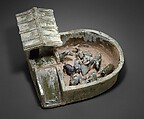Animal Pen with Figures
This animal pen is populated with goats, tended to with one hand by a mother who cradles an infant in her other arm. It is typical of mingqi or "spirit utensils" that accompanied the deceased in burials of the Eastern Han dynasty (25–220 A.D.). Replicas of farm animals, utilitarian objects, and entertainers were believed to provide nourishment and amusement for the soul of the tomb occupant. The elevated structure serves as an architectural record of rustic buildings that would have been part of a large agricultural estate, and preserves in clay details of wooden design and construction—such as the low-pitched roof with a series of wood rafters flanging from a central beam—that have long since disintegrated above ground.
The popularization of mingqi over the course of the Han dynasty (206 B.C.–220 A.D.) reflects dramatic changes in Chinese society, illustrating how power circulated beyond the imperial government and nobility to a broader bureaucratic class. In the early years of the Han, Confucianism emerged as the dominant philosophy and the empire became dependent on a class of scholar-officials. They desired gratification for themselves and their families in the afterlife and plentiful clay, fashioned into models ranging from crude earthenware to fine glazed stoneware, was the ideal medium for furnishing mingqi in burials across a swath of social strata.
Due to rights restrictions, this image cannot be enlarged, viewed at full screen, or downloaded.
This artwork is meant to be viewed from right to left. Scroll left to view more.



